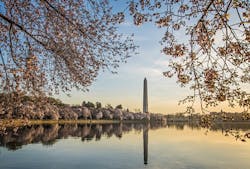The nation's capital of sustainable design
Cities are the laboratories of innovation that power the world. They also hold the key to avoiding the most devastating impacts of climate change. Major cities, like Washington, D.C., make up less than 2% of the world’s landmass, but they contribute 77% of the world’s CO2 emissions. Based on the dense concentration of wealth, infrastructure, and people located in urban areas, it makes sense that the sustainable transformation of the world’s cities has become a focus of the climate change movement.
The District of Columbia is a model of sustainability leadership thanks to the passage of the Green Building Act of 2006 and the D.C. Green Construction Code. As a result of those measures, the D.C. metro area currently leads the nation in per capita square footage of LEED space and features a total of more than 156 million square feet of LEED certified space. An impressive 10% of that space has achieved LEED Platinum certification, including PNC Place and the Gensler-designed General Services Administration’s (GSA) swing space (which will become the home of the Peace Corps in 2020). As if that weren’t enough, D.C. has also topped the Environmental Protection Agency’s (EPA) ENERGY STAR cities list for three years running. Given such a track record, it should come as no surprise that the U.S. Green Building Council also named our nation’s capital as the world’s first LEED Platinum city, in 2017.
Municipalities across the country are now beginning to follow the District’s lead. In fact, jurisdictions in D.C.’s own backyard have taken some aggressive steps on the sustainability front. Arlington County, VA, located adjacent to Washington, was just named the U.S. Green Building Council’s first Platinum level community for its green building efforts. And in nearby Tysons Corner, Va., Tysons Tower is one of many buildings to seek LEED certification in part because D.C.’s sustainability efforts have both raised the bar for green construction across the region and made potential tenants more aware of the benefits of a sustainable work environment.
Interior of D.C.’s LEED Platinum PNC Place. Image © Prakash Patel.
Much of D.C.’s success has to do not just with encouraging green design and construction practices but also with implementing urban planning measures that make the city more eco-friendly. For example, D.C. has made a commitment to growing its tree canopy, introduced a bikeshare program and more than 100 miles of bike lanes and trails, and ranks high in walkability according to both Smart Growth America and Walk Score.
For a number of cities across the U.S., there are opportunities to improve on such fronts. That’s why Gensler has recommended each of the above, along with a number of other green planning and design strategies for cities, in our Impact by Design report. Impact by Design is intended to inform targeted conversations across a range of scales—from the level of the city or district, down to individual buildings, and finally to interiors. In addition to recommending increased tree canopy coverage and improved bike and pedestrian accessibility, Impact by Design also argues for the creation of eco-districts that employ various methodologies to create resource-efficient and resilient neighborhoods. And it recommends the development of net metering and smart metering districts that capture real-time energy use to more efficiently manage and energy needs.
Though much of Impact by Design is geared toward informing ways to improve the performance of the built environment, part of it is also geared toward understanding our firm’s own impact in cities like Washington, D.C., and the other locales that we call home. What the report uncovered is that across our entire firm, our projects in 2016 (the most recent year for which we have complete data) were designed to offset 11 million metric tons of CO2 annually. To put that in perspective, that’s the equivalent of removing 2.34 million passenger vehicles from our roads—and the 26.5 billion miles they drive—for one year.
While our firm is proud to do its part to combat climate change, we understand that scaling up the level of impact will require a long-term commitment to conversations and partnerships with cities. After all, climate change is a long-term problem. Yet sustainable design, planning, and construction practices have the kind of multi-generational impact that’s needed to mitigate the worst outcomes associated with a warming planet. Each building we erect will be in continuous use for at least 20 to 50 years, if not longer. By making those buildings green, we can not only provide people with healthy places to spend their time but also help shrink the energy and water needs of entire communities.
Thankfully, more and more people view sustainable cities like our nation’s capital as ideal places to live and work. The planet agrees with them.
